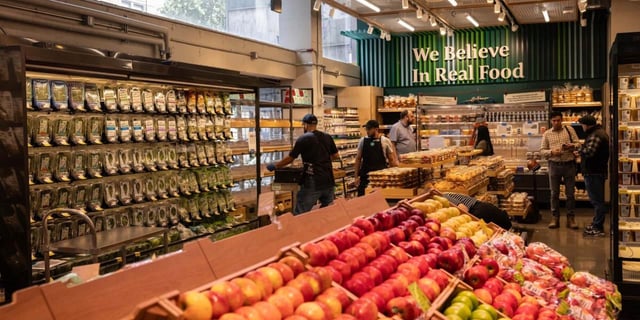The “Whole Paycheck” Era Might Be Over: Is Amazon Finally Re-Shaping Whole Foods?
Remember the days when a trip to Whole Foods felt like a venture into a land of organic quinoa, artisanal cheeses, and prices that made your wallet weep? That pristine image of high-end, health-focused exclusivity may be fading, as the influence of its parent company, Amazon, becomes increasingly apparent. The “Amazonification” of Whole Foods is no longer a whispered prediction; it’s happening, and it’s bringing changes that might just surprise you, possibly even welcoming Doritos into the aisles. But is this a good thing?
The Blurring Lines: What “Amazonification” Actually Means
The term “Amazonification,” in this context, refers to the integration of Amazon’s business strategies and operational philosophies into Whole Foods. This goes beyond simply offering Prime discounts. It encompasses changes in product selection, pricing strategies, technology integration, and overall customer experience. We’re talking a fundamental shift in how Whole Foods operates, moving away from its perceived exclusivity and towards a broader, more accessible market. Think algorithms determining shelf placement, increased use of data analytics to personalize promotions, and a relentless focus on efficiency and cost reduction.
For years after the acquisition, many felt Amazon was hesitant to fully overhaul Whole Foods, perhaps fearing alienating its core customer base. However, signs are now pointing towards a more assertive approach. Amazon appears to be implementing strategies honed from its e-commerce dominance to streamline operations and attract a wider range of shoppers, even if it means deviating from Whole Foods’ original, hyper-focused identity.
From Kale to Convenience: Product Selection and Pricing
One of the most noticeable shifts is in product selection. While organic produce and specialty items will likely remain a core offering, we’re seeing an influx of more mainstream brands and products. This could mean more recognizable snack brands, everyday pantry staples at competitive prices, and even…dare we say it…a wider selection of conventional (non-organic) options. The goal here is clear: broaden appeal and attract customers who might have previously been intimidated by Whole Foods’ perceived exclusivity and high prices.
This shift is further amplified by Amazon’s push for more competitive pricing. Prime members already enjoy discounts, but we’re seeing more frequent sales and promotions across the store. Amazon’s vast supply chain and bargaining power allow it to negotiate better deals with suppliers, translating to lower prices for consumers. This is a crucial element in attracting a more price-sensitive audience and competing effectively with traditional supermarkets.
Consider the implications for local and smaller organic brands. While Whole Foods initially championed these businesses, the focus on competitive pricing could prioritize larger, more established suppliers that can offer lower costs. This may result in a less diverse selection and potentially disadvantage smaller companies that rely on Whole Foods’ platform for growth.
Tech Integration: Scan, Pay, and Go (Faster!)
Amazon’s tech prowess is also transforming the shopping experience. We’re seeing more Amazon-powered features, like Amazon One palm-scanning payment systems, and the expansion of “Just Walk Out” technology, which allows shoppers to grab items and leave without going through a traditional checkout. This streamlined process not only enhances convenience but also reduces labor costs, contributing to lower prices and increased efficiency.
The increased reliance on data collection through these technologies also allows Amazon to better understand customer preferences and tailor promotions accordingly. Imagine walking into Whole Foods and receiving personalized offers based on your past purchases or browsing history. This level of personalization, while potentially convenient, also raises concerns about privacy and data security.
Furthermore, the focus on technology could inadvertently alienate some customers who prefer a more traditional shopping experience. The human element of customer service, such as interacting with knowledgeable staff, might be diminished as technology takes center stage.
The Future of Whole Foods: Evolution or Erasure?
So, what does the future hold for Whole Foods? Is it destined to become just another cog in the Amazon machine, sacrificing its unique identity in the pursuit of market share? Or can it successfully blend Amazon’s operational efficiency with its original commitment to high-quality, healthy food? The answer likely lies somewhere in the middle.
The “Amazonification” of Whole Foods is undeniably changing the shopping experience. While some purists might lament the loss of exclusivity, others will welcome the lower prices, increased convenience, and broader product selection. Ultimately, the success of this transformation will depend on Amazon’s ability to strike a balance between efficiency and authenticity, preserving what made Whole Foods special while making it accessible to a wider audience. Perhaps, alongside the organic kale and artisanal cheeses, we will soon find that bag of Doritos – a symbol of a new, more inclusive Whole Foods. The question is: will it be the organic, non-GMO Doritos?
